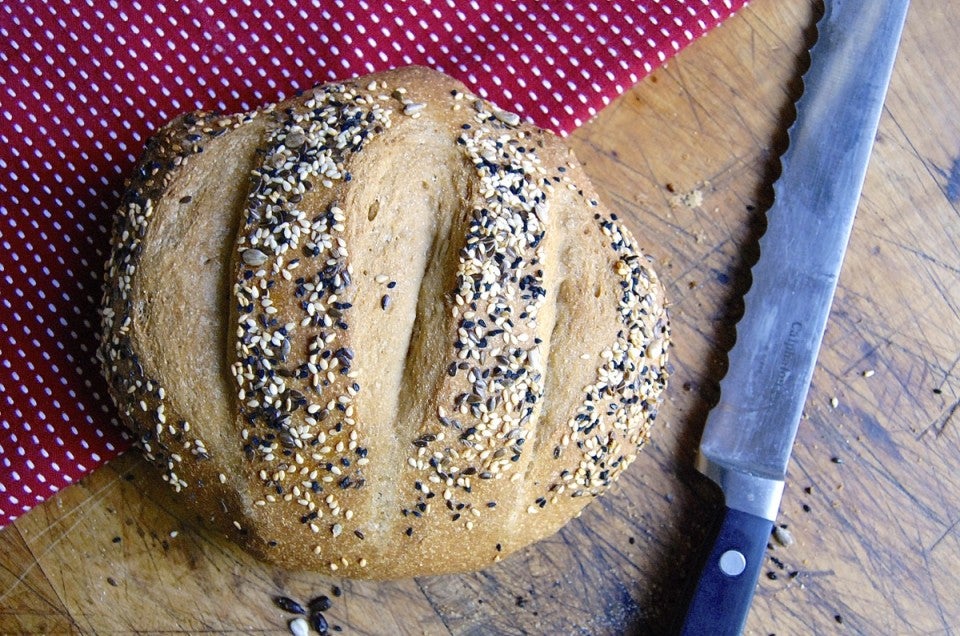


OK, so you've made no-knead bread. Maybe you've taken that no-knead dough and shaped it into pizza crust; or frozen it for future use. What's your next delicious experiment? Whole wheat no-knead bread — naturally!
Thankfully, we can go into this experiment well-armed with a thoroughly researched method and painstakingly tested recipe, thanks to Jeff Hertzberg and Zoë François, who literally wrote the book — make that "books" — on no-knead bread.
Hertzberg and François have penned a series of no-knead bread books, starting with Artisan Bread in Five Minutes a Day, and including Healthy Bread in Five Minutes a Day, from which we drew inspiration for the recipe in this blog post. Experts in the genre, the authors are the go-to source for many seeking to emulate baker Jim Lahey, who premiered the concept, and New York Times columnist Mark Bittman, who gave it wings by publishing his seminal no-knead recipe 10 years ago.
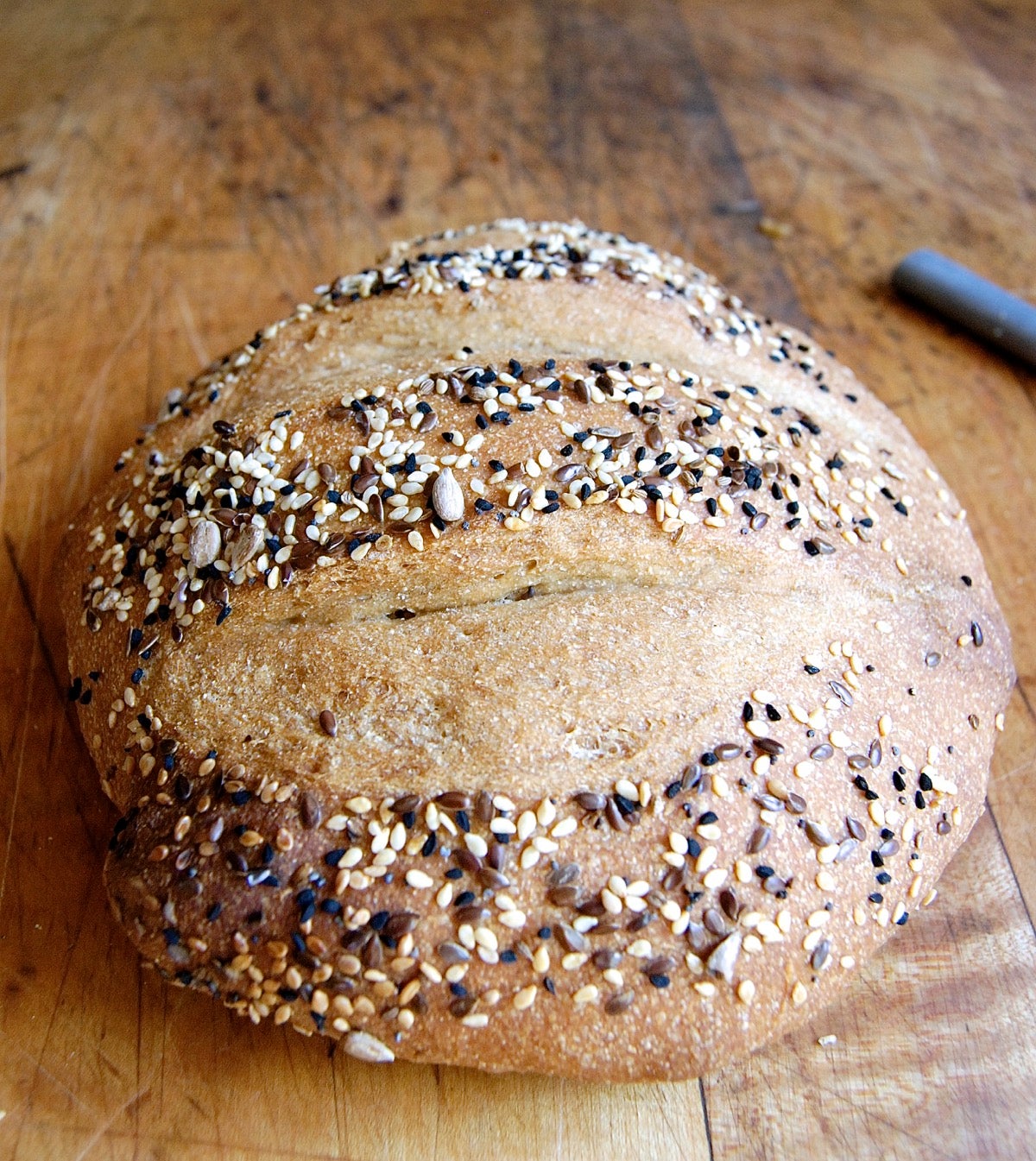
This particular bread is made with three parts whole wheat flour to one part all-purpose, plus vital wheat gluten for extra strength and better "rise-ability." The result? Whole wheat no-knead bread with plenty of lift and a nice wheaty flavor. Not only that, you'll feel virtuous while eating it — win-win!
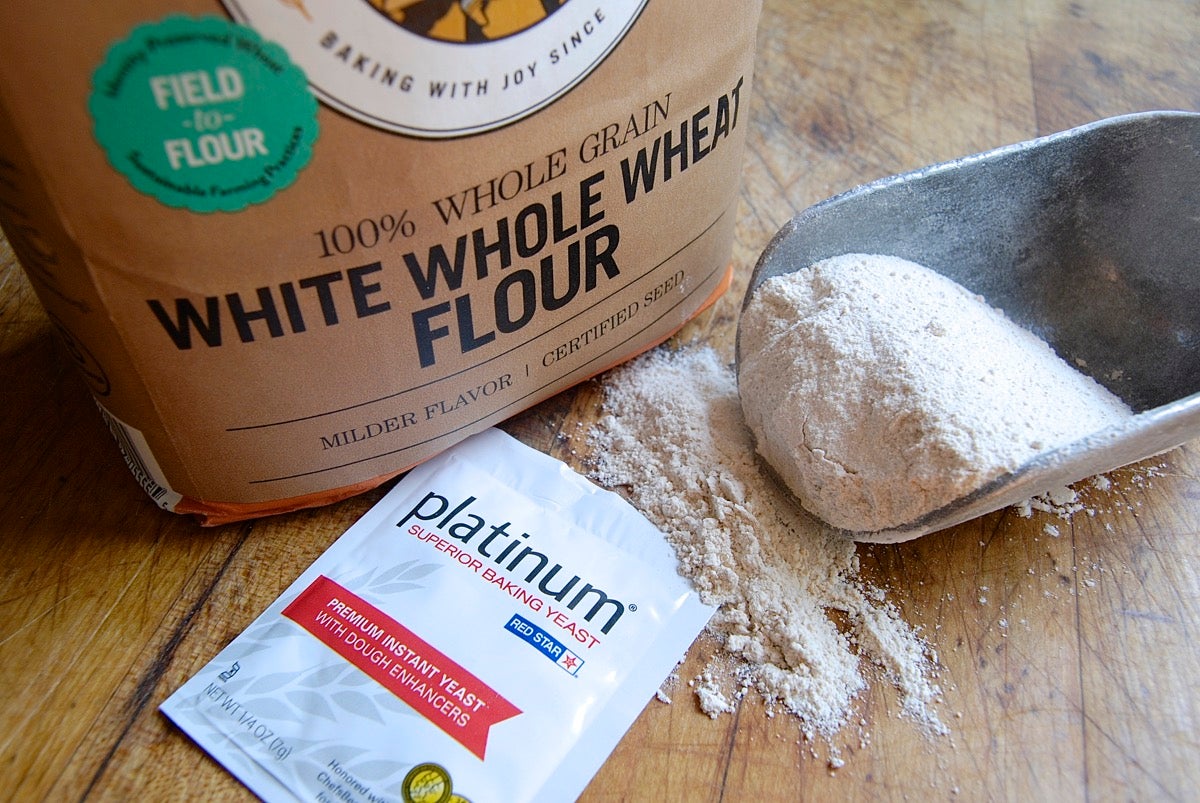
Let's start with some key ingredients: flour and yeast.
Our golden whole wheat flour is lighter in color and milder in flavor than traditional red whole wheat flour — but make no mistake, it's 100% whole wheat, with all of its vitamins, minerals and fiber intact.
We use Red Star Platinum or SAF instant yeast in our King Arthur test kitchen; both are reliable, strong yeasts with good staying power, perfect for no-knead bread.
Let's go ahead and stir up this easy dough.
Mix the following together:
5 1/2 cups (624g) King Arthur Golden Whole Wheat Flour
2 cups (240g) King Arthur Unbleached All-Purpose Flour
2 tablespoons (18g) vital wheat gluten
1 1/2 tablespoons (14g) instant yeast or active dry yeast
1 tablespoon salt
3 1/4 to 3 1/2 cups (737g to 794g) lukewarm water*
*If you measure flour by sprinkling it into a cup and sweeping off the excess, use 3 1/4 cups water. If you measure by dipping your measuring cup into the flour canister, tapping it to settle the flour, then leveling it off, use 3 1/2 cups water.
Note: Read the following if you're a bread science fan; it's interesting, though not critical. The balance of water and flour is the only tricky part of this recipe; it's important to get it just right. Nail it, and your bread will rise nicely, and have a chewy crust and moist interior. Too much water, it'll have a very open (holey) texture and not rise well; too little water, and the bread will be dry.
The hydration (weight of water compared to flour) is 75% in this recipe for No-Knead Crusty White Bread. But since whole wheat flour absorbs more liquid than all-purpose flour, we're going to increase the hydration in this recipe to 85% to 90% or so.
Why the two options for amount of water? Use the lesser amount of water in a humid environment, or during the summer; the greater amount when it's dry, or during the winter.
What's the difference? Flour is like a sponge; it absorbs moisture from the air. When it's humid out, your flour is moist; when it's dry, so is your flour. Slight adjustments in liquid amounts in your yeast bread recipes, according to season/climate, can yield the consistent results you're seeking.
Mix everything together until well combined. The dough will be quite sticky; it's good we're not going to have to knead it.
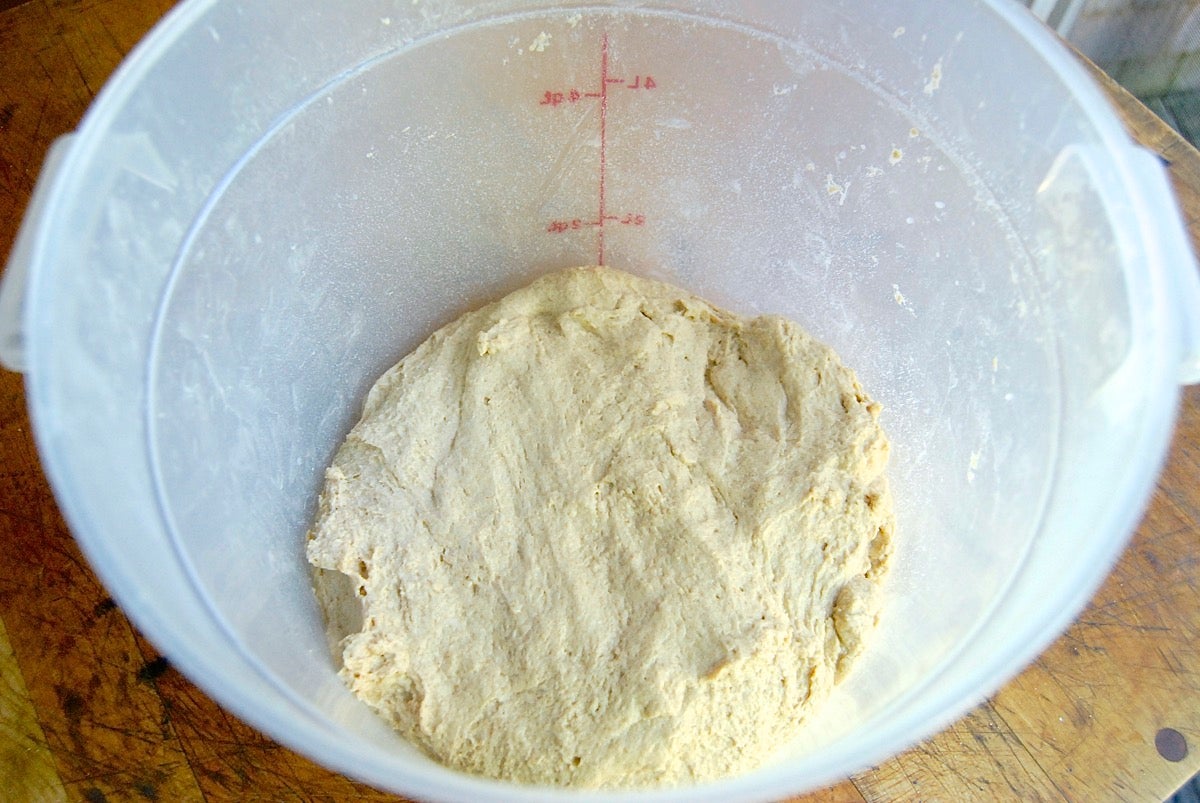
Put the sticky dough into a large bowl or dough bucket, greased or not; it's not critical to grease the container.
Cover lightly; don't snap the lid on the bucket.
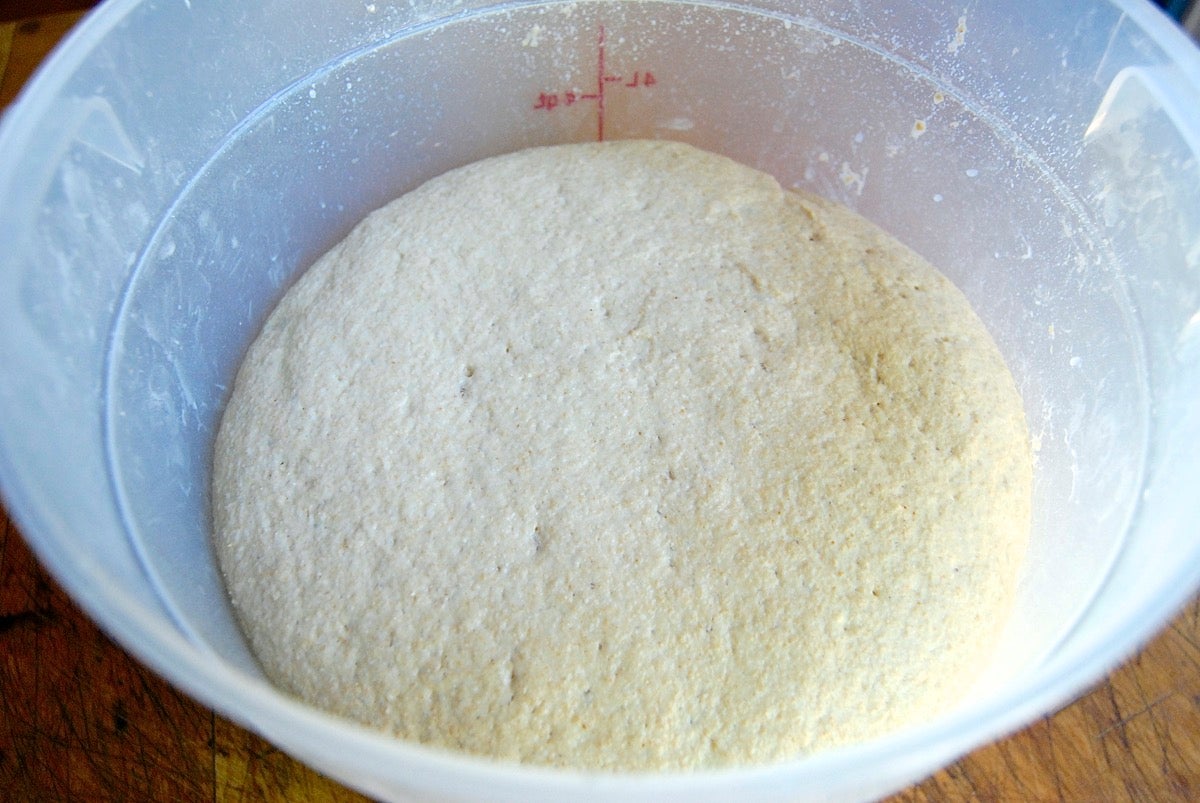
Two hours at room temperature should do it; it'll about double in size.
Cover the bowl or bucket so it's airtight, and refrigerate overnight, or for up to 7 days or so. The longer the dough chills, the more sourdough-like tang you'll taste in your bread.
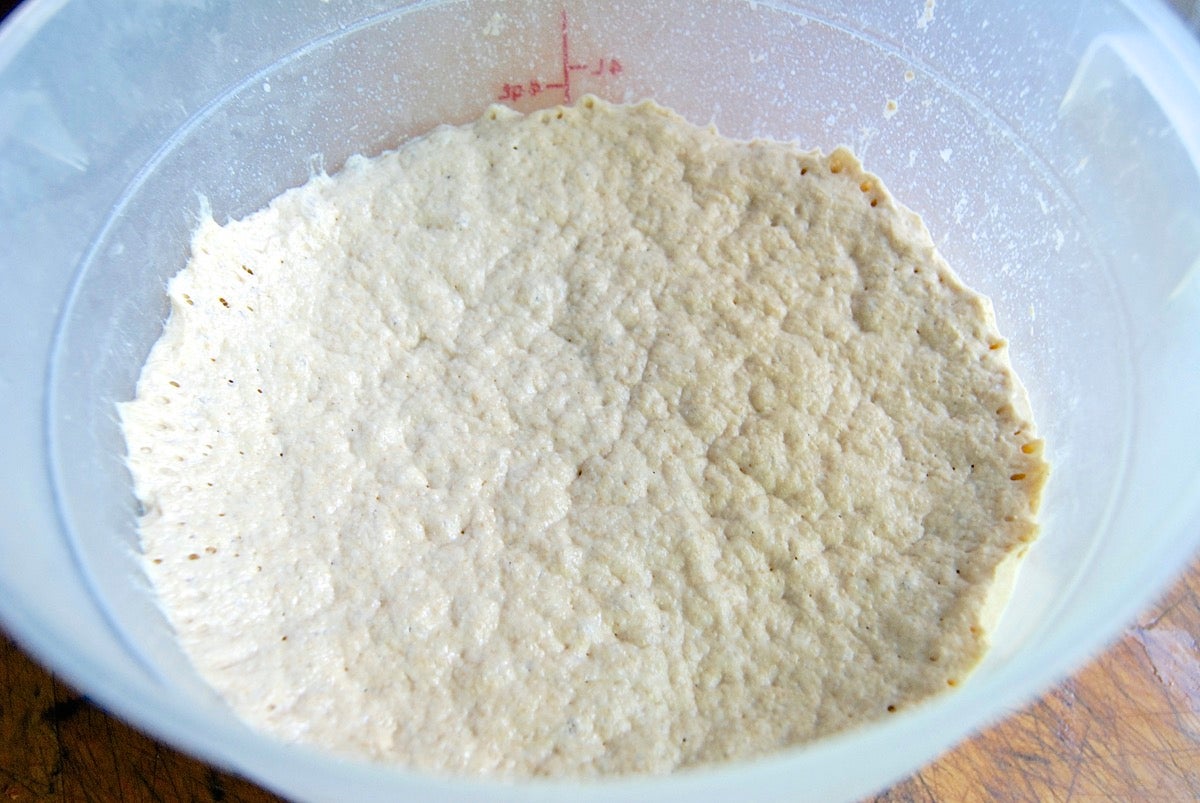
When you're ready to bake, remove the bucket from the fridge. You'll notice the dough has collapsed a bit; this is perfectly normal.
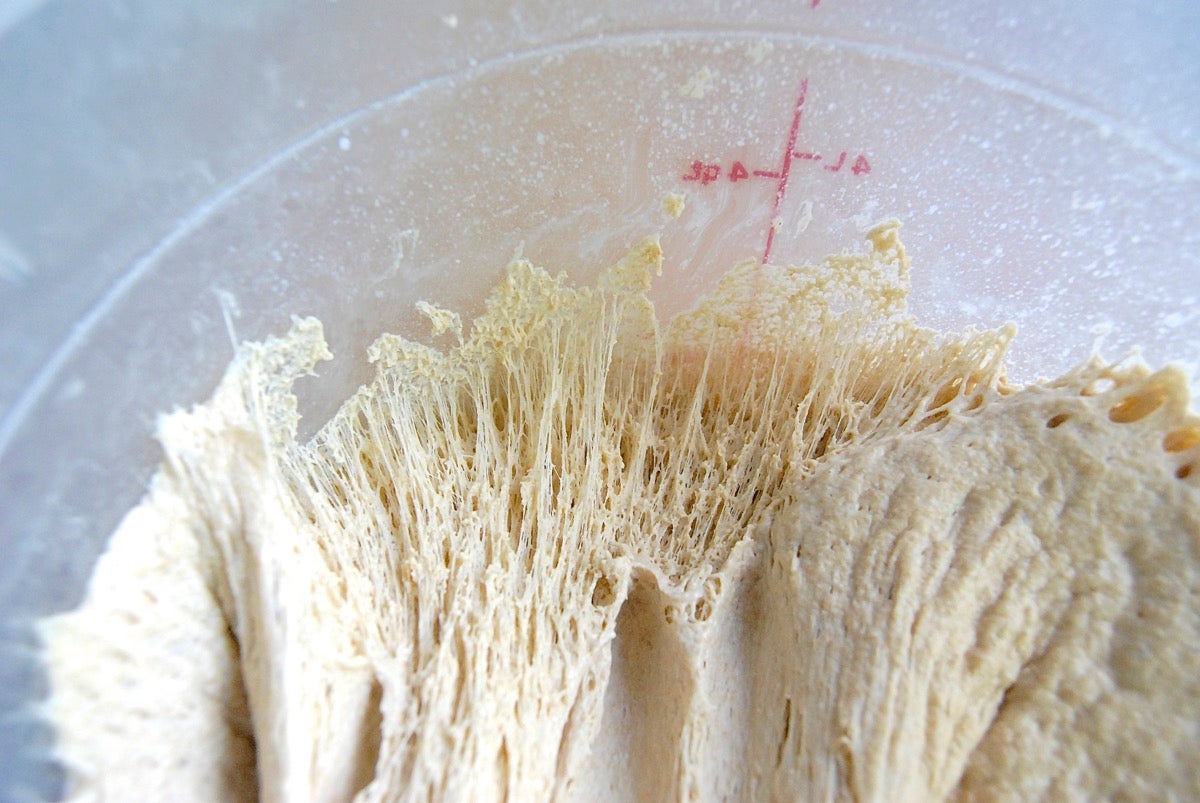
It should weigh about a pound. As you do this, you'll see long strands of stretchy dough clinging to the sides of the container. This is evidence the dough has developed its gluten completely without kneading, simply by resting in the refrigerator. Cool, huh? (Pun intended.)
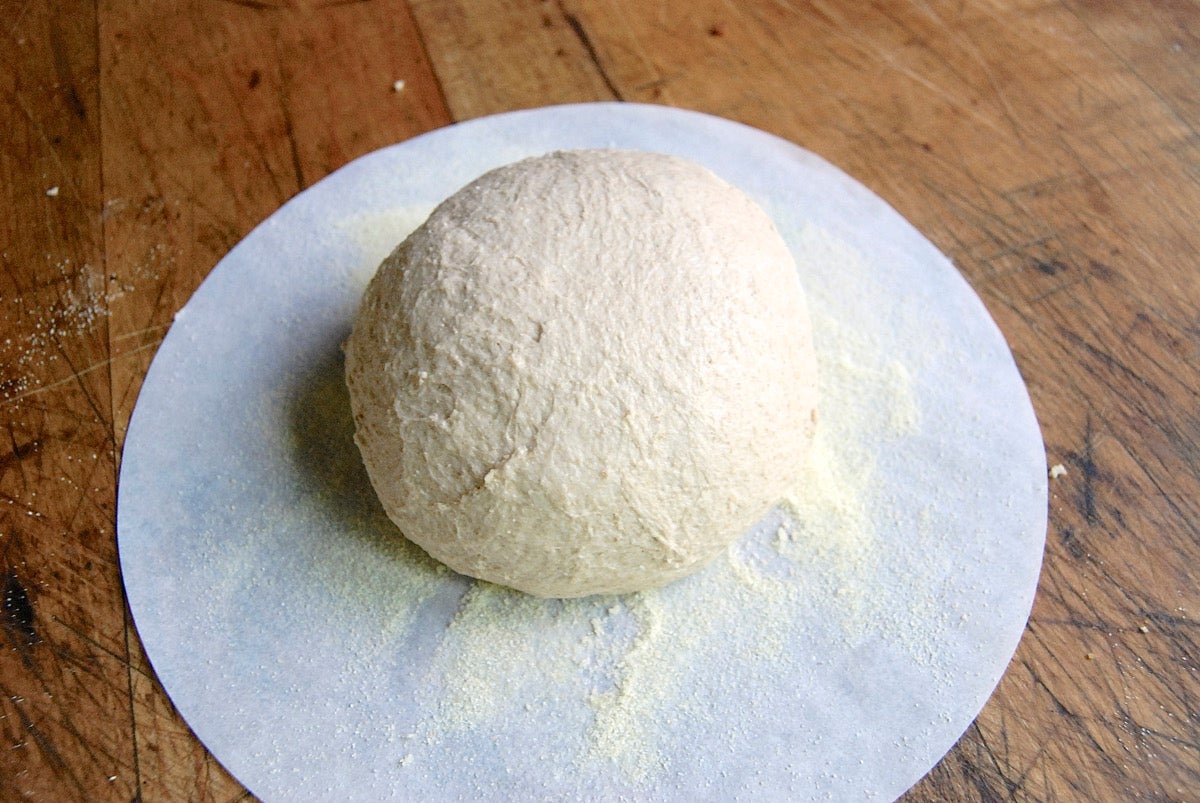
Place it on a piece of parchment (I'm using a 9" round here) that you've sprinkled with semolina, cornmeal, or flour. These will help keep the dough from sticking to the parchment.
And why place it on parchment, anyway? If you're going to bake the bread on a pizza stone, parchment makes moving the loaf around fail-safe.
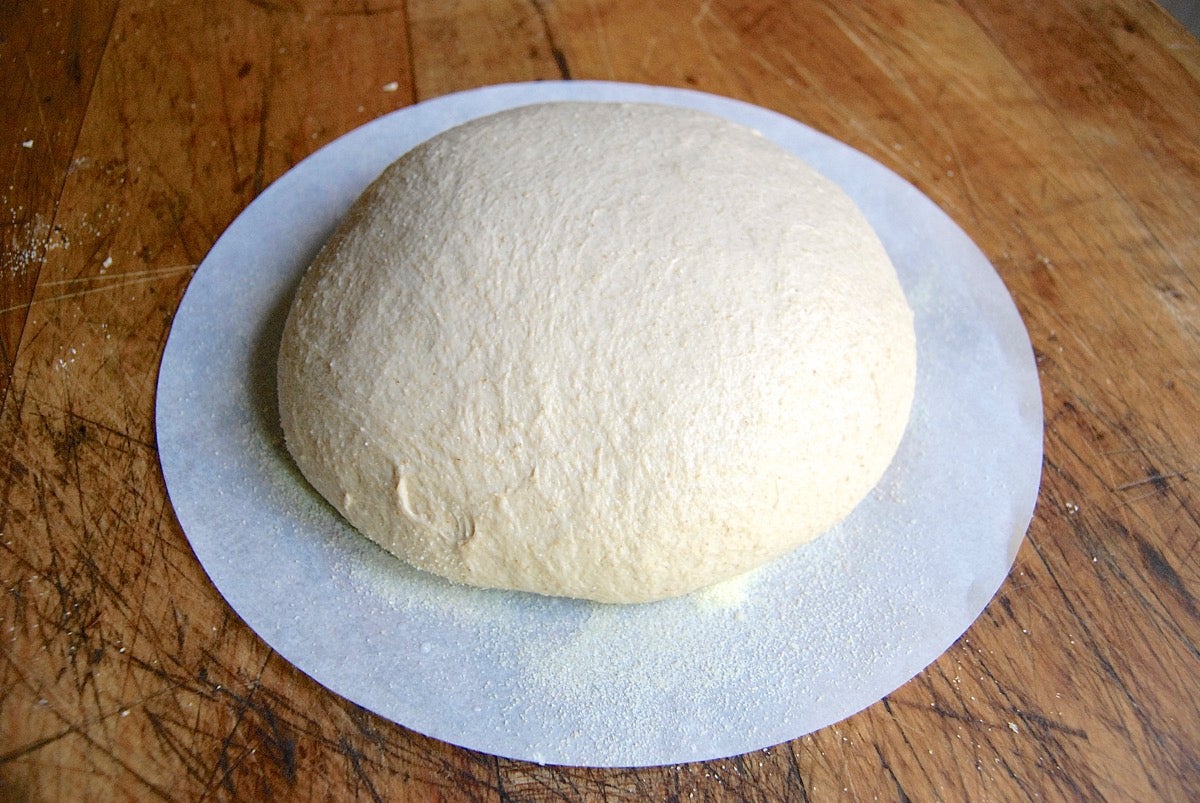
Cover the loaf, and let it warm up and rise for 2 hours at warmish room temperature (about 75°F to 80°F is good). If your house is cold, try putting the bread in your turned-off oven with the oven light on. The light bulb will produce just enough heat to keep the loaf comfortable.
After 2 hours, your loaf should have expanded noticeably. It'll spread more than rise upward, but that's OK.
While the bread is rising, preheat your oven to 450°F. If you have a pizza stone, put it on a lower rack and let it heat up as the oven warms.
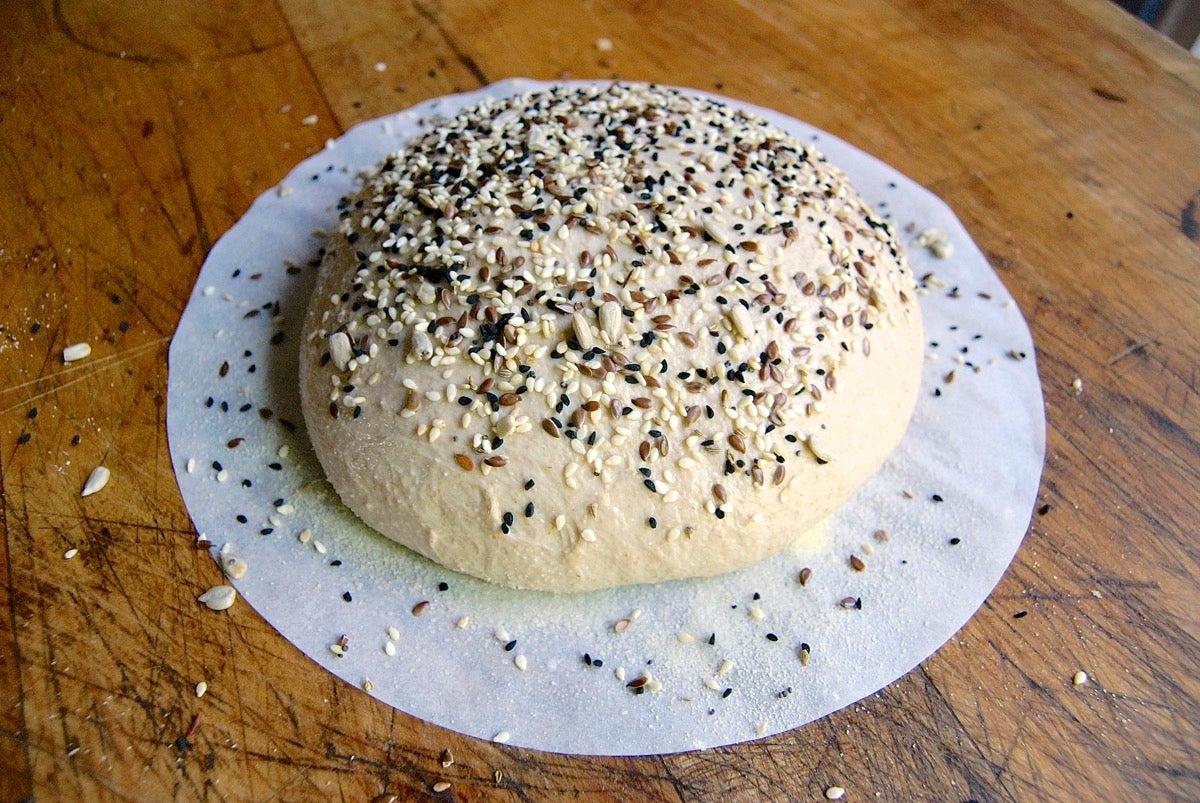
Just before baking, brush or spray the loaf with lukewarm water, and sprinkle it with seeds, if desired. I'm using our Artisan Bread Topping mix here.
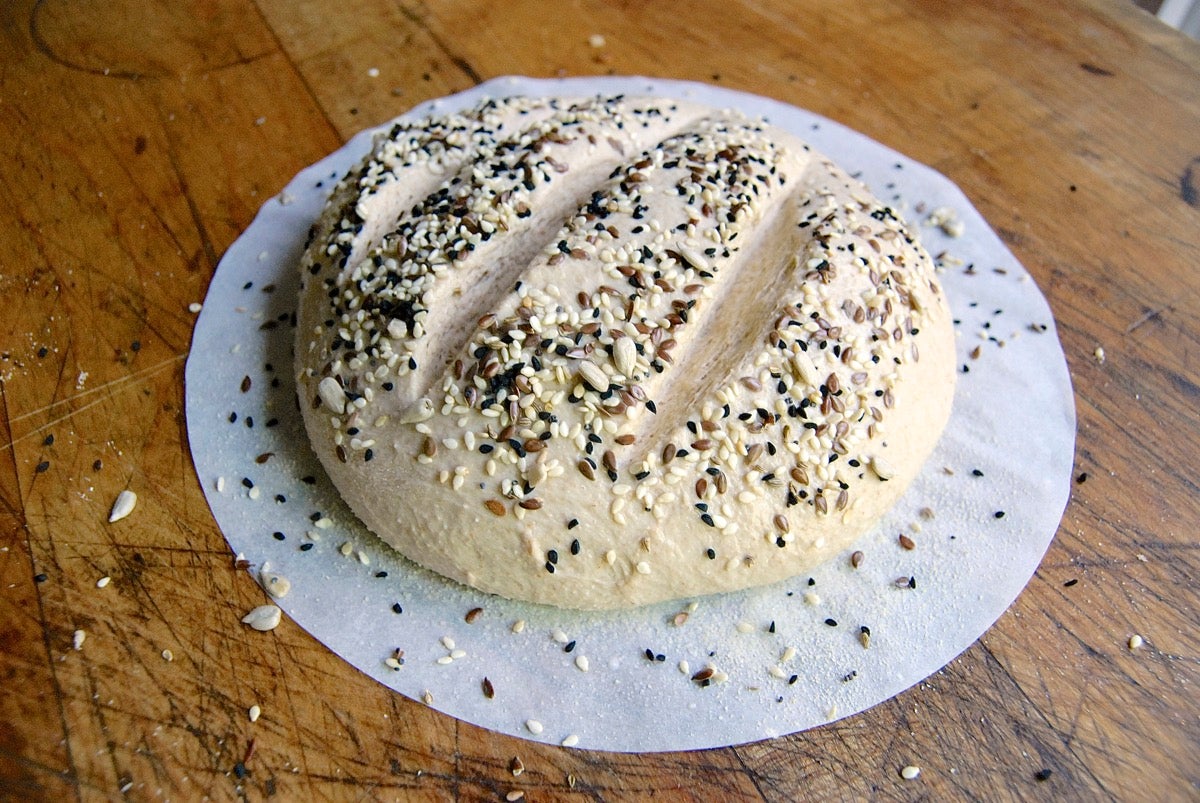
Use a sharp knife or lame to give the bread three quick slashes, about 1/2" to 3/4" deep.
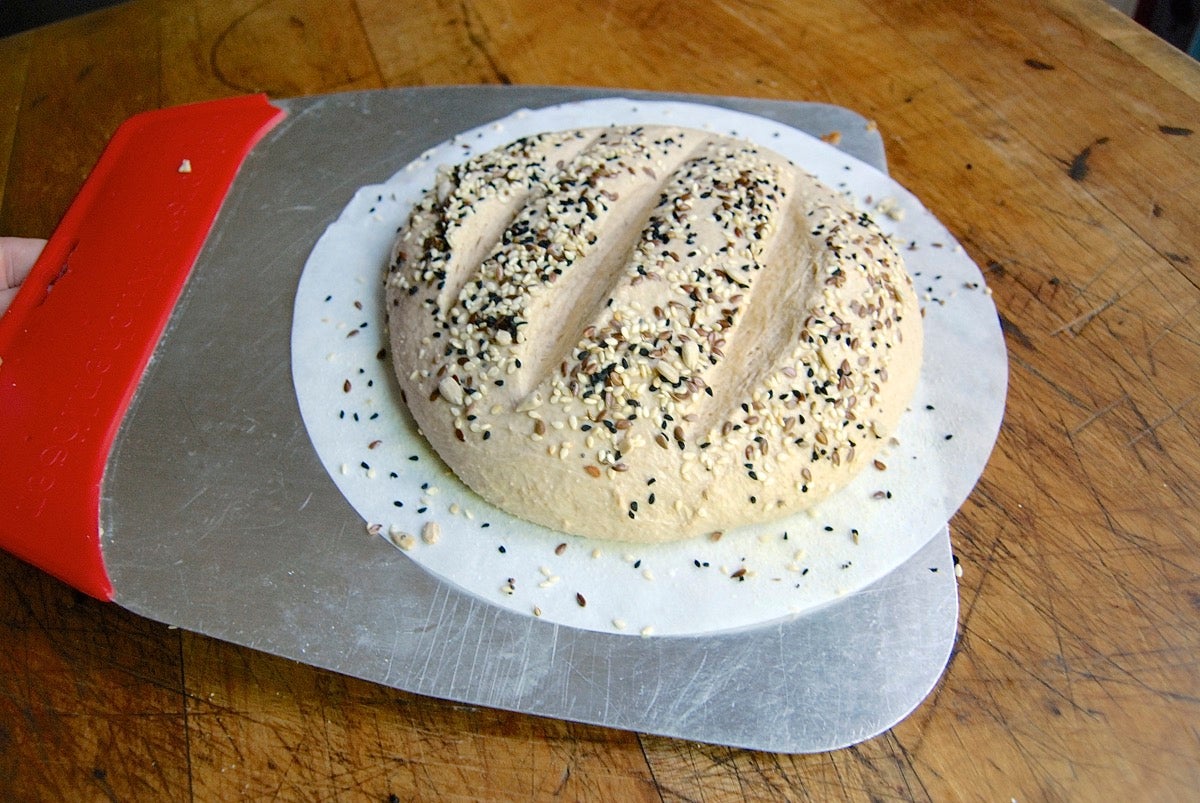
Transfer the bread to the pizza stone; a giant spatula works well here.
If you're not using a pizza stone, place the bread on a baking sheet, and put it into the oven.
Bake the bread for about 20 minutes, until it's golden brown and a digital thermometer inserted into the center reads at least 190°F.
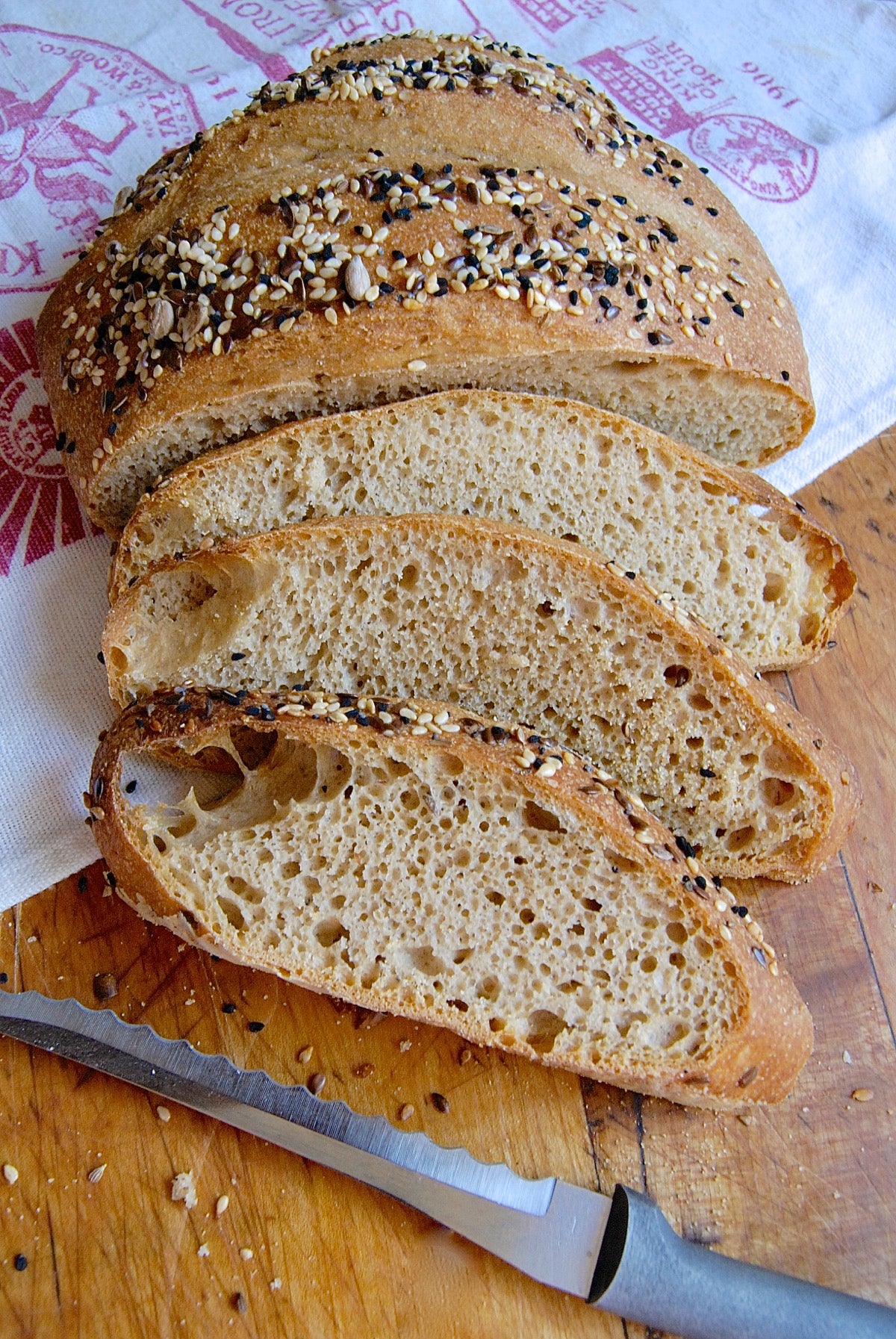
Remove the bread from the oven, and inhale its rich scent. Wait until the bread is completely cool before slicing; cutting into a loaf of hot bread can make it irreparably gummy.
Store completely cooled bread, well wrapped, at room temperature for a couple of days; freeze for longer storage.
But wait, there's more! More dough in your fridge. This recipe makes about three medium loaves plus one smaller loaf. Try baking dough that's been refrigerated for one day, then bake some after three days, then five days — see and taste the difference. You'll soon discover your own sweet spot for length of chill.
Again, my thanks to Jeff Hertzberg and Zoë François for their relentless championing of this user-friendly bread-baking technique. And for their master recipe for whole wheat no-knead bread, which inspired this blog post. You can find our take on their recipe here.

